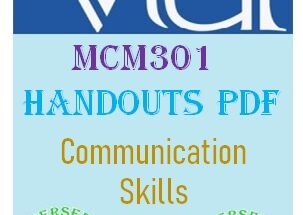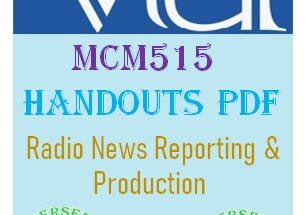Table of Contents
MCM511: Theories of Communication
Communication is the act of transferring information from one place, person, or group to another. All communications include (at least) one sender, message, and recipient. This may sound simple, but communicating is actually a very complex matter. MCM511 Handouts pdf
MCM511 Handouts pdf
Course Category: Mass Communication MCM511 Handouts pdf
Course Outline
Defining communication, Paradigms, What is a theory, Kinds of problems theory addresses, Communication processes, Concept of Mass Communication, Normative theories, Authoritarian theory, Libertarian Theory, Civic or public journalism, Limitations of Media Theory, Commercialism, How the idea of Propaganda emerged in the mass society, Limited Effects of Media, Middle range theory and the Mass consolidation of the limited effects, Klapper‘s Phenomenistic theory, Diffusion theory, Challenging the Dominant paradigm, Social Cognitive Theory, Observational Learning and Modeling, Abstract modeling, Modeling from Mass Media, Variables that enhance priming effects, Cultivation of perceptions of social reality,
Systems Theories of Communication Processes, Systems Theories Of Communication Processes, Mathematical theory of communication, Applying systems models to human communication, Emergence of critical and cultural theories of mass communication, The mediation concept, Positions Relating to Social Integration, Rise of cultural theories in Europe Marxist Theory, Key arguments in Marxist perspective, Marxist theory, Communication and culture, The Frankfurt School, Culture Industry, Hegemony, Political economy theory, Four ways in which media owners limit diversity, Criticism on Political Economy Theory, Power of Advertising, Agenda-setting theory, Spiral of silence theory, Marshall McLuhan: the medium is the message and massage, Knowledge gap theory, Media Systems Dependency theory,
Uses and Gratification Theory, Reception Analysis Theory, Framing and Framing Analysis, Information Processing Theory, Trends in Mass Communication, Interpersonal Communication, Communication Channels, Interpersonal Communication, Types and Four Principles of Interpersonal Communication, Barriers against Effective Interpersonal communication, Overcoming the Barriers of Effective Interpersonal Communication, Globalization problems, Media Literacy Movement, MCM511 Handouts pdf
ALSO, SEE:
Jazz Internet Packages | Daily, Weekly, and Monthly and 3-Day Jazz
Zong free internet code 2022 | Get Free internet 3G/4G
TELENOR FREE INTERNET PACKAGES
Join VU assignment solution groups and also share with friends. We send solution files, VU handouts, VU past papers, and links to you in these WhatsApp groups. To join WhatsApp groups click the below links.
JOIN VU STUDY GROUPS

MCM511 HANDOUTS
MCM511: Theories of Communication
Defining a connection
Communication seems to be the backbone of our day-to-day life. Not surprisingly, academics have tried to unravel the mysteries of the communication process. In this section of the study, we will examine the theory and theory of this field of communication. To understand communication theory, we need to understand the nature of communication.
The nature of communication
People interpret terms in different ways, and that difference in meaning can have a profound effect on our level of understanding and our progress in both academic and day-to-day activities.
There are significant differences in definitions. Some are very clear and some are very clear. A few explanations are listed below.
Communication is the process by which a person (the link) conveys motives (usually orally) in order to change the behavior of other people (the audience). (Hovland Janis and Kelly, 1953)
Communication is the process by which we understand others and try to be understood by them. Powerful, ever-changing and flexible in response to perfect conditions (Anderson, 1959)
Communication is all the processes by which one mind can influence another (W. Weaver, 1949) Communication means that information is transferred from one place to another. (Miller, 1951)
These definitions are incomplete in the sense that Weaver’s definition is incredibly broad; encompasses all processes in which one “concept” may influence another, while other definitions do not include the very many functions that we often think of as communication. However, through this confusion of meaning many aspects of the concept have emerged as important points to discuss.
Communication is a Process:
The concept behind the communication process suggests that it is continuous and complex and cannot be isolated in isolation. David Berlo in 1960 expanded this view with these words. “When we embrace the concept of process, we view events and relationships as a dynamic, continuous, dynamic, continuous process. When we write something as a process, we also mean that it has no beginning, no end, no fixed sequence of events. It does not stop at rest. It goes. The ingredients within the process interact; each affects the other. ”
Transactional Approach
Communication is a transaction so it is very complex. The concept of action is useful to compare it with related ideas of action and interaction. If we regard communication as a solid action, a source that conveys a message to the recipient or audience, we will not consider the audience’s response or response. This is a linear model of one-way communication and is also called a hypodermic needle model or a magic bullet connection method.
Communication is symbolic:
The third part of the encounter in communication ideas is the belief that communication is a symbol. To explore this concept, it is helpful to talk briefly about the general concept of the brand, which is being investigated in the field of semiotics.


